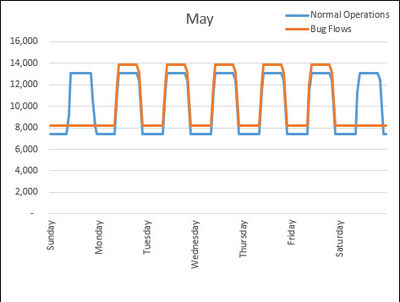Difference between revisions of "The Bugflow Experiment"
Cellsworth (Talk | contribs) (Created page with "---- __NOTOC__ __NOEDITSECTION__ <!-- ------------------------------Banner across top of page------------------------------> {| style="width:100%; background:#fcfcfc; margi...") |
Cellsworth (Talk | contribs) |
||
| Line 17: | Line 17: | ||
</table> | </table> | ||
| − | [[File: | + | [[File:BugflowHydrograph.jpg|400px]] |
<!-- | <!-- | ||
| Line 24: | Line 24: | ||
|style="width:60%; font-size:120%;"| | |style="width:60%; font-size:120%;"| | ||
| − | '''What is the “bug flow experiment?''' | + | '''What is the “bug flow experiment?''' <br> |
| − | + | This would be an experimental release at Glen Canyon Dam to see if short-duration steady flow might increase the diversity and production of aquatic insects below Glen Canyon Dam. This experiment is included in the Preferred Alternative of the LTEMP DEIS. These “bug flows” would occur from May to August and would maintain releases on the weekends to a level equal to the minimum release made during the week. This would allow aquatic insects two days a week throughout the river corridor to be able to lay their eggs at a stage where they would not be at risk of being dewatered or desiccated. The experiment would include monitoring to evaluate if the flows did increase the diversity and production of aquatic insects. The experiment was designed to test the hypothesis put forward in Kennedy's 2016 BioScience Paper while minimizing impacts to the hydropower resource at Glen Canyon Dam by having the steady flows on the weekend. This results in a transfer of water from the weekend to the weekdays increasing the daily minimums and maximums and the range of fluctuation during the week. Western believes that this experiment will result in only a small decrease in the energy value, but a modest increase in the capacity value of hydropower produced at Glen Canyon Dam. | |
| Line 56: | Line 56: | ||
|- | |- | ||
|style="color:#000;"| | |style="color:#000;"| | ||
| + | |||
| + | Modeling Assumptions: | ||
| + | *Bug flows would occur every weekend from May - Aug (34 days, we scheduled July to have the 5th weekend because that how it works out in 2016) | ||
| + | *Weekend flow = minimum flow for the month = weekday minimum flow (see weekly hydrographs on the monthly tabs) | ||
| + | *Hybrid Public Draft monthly volume, ramp rates, or daily change parameters | ||
| + | *Moved weekend water to weekday releases | ||
| + | *Energy prices used in this modeling are for a Saturday, Sunday, and a weekday for May, June, July, and August 2016. These are the energy prices Argonne used in the LTEMP modeling for 2016. | ||
| + | |||
| + | Hybrid Public Draft 8.23 MAF volumes: | ||
| + | *May = 632 | ||
| + | *June = 663 | ||
| + | *July = 749 | ||
| + | *August = 800 | ||
| + | |||
| + | Ramp rates: 4,000 up and 2,500 down | ||
| + | |||
| + | Daily change: | ||
| + | *May = 9 | ||
| + | *June = 10 | ||
| + | *July = 10 | ||
| + | *August = 10 | ||
| + | |||
| + | Minimum release: 5,000 cfs | ||
| + | Maximum release: 25,000 cfs | ||
Revision as of 15:25, 26 July 2016
|
|
What is the “bug flow experiment?
|
| --- |
--- |
--- |
|---|
|
|
